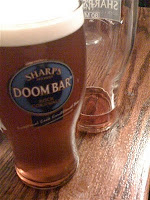Prompted by
this post on Mark Dredge’s blog, I ran a poll asking whether people bought the
Good Beer Guide. There were 77 responses, broken down as follows:
Every year: 17 (22%)
Every two or three years: 7 (9%)
Occasionally: 3 (4%)
I have an old copy I still use: 5 (6%)
I once bought one but have long since lost it: 6 (8%)
Never bought one: 39 (51%)
Obviously quite a lot of readers of this blog aren’t real ale drinkers, so you would expect “never bought one” to be the biggest category. However, the second highest is those who buy one every year. Although far from CAMRA’s cheerleader-in-chief, I have in fact bought every single copy since 1978, and I always regret throwing away the 1978 edition, which was the last to use “blobs” to identify beers rather than actually naming them in the pub entries.
I was a little surprised that Mark didn’t see much point in buying it. However, the main reason people buy it, I suspect, is not that they are fanatical beer geeks or tickers, but they uses it as a guide to pubs worth visiting when on holiday, away on business or out on day trips. It is, in effect, not so much a beer guide as a more down-to-earth version of the
Good Pub Guide. To this end, from a personal point of view it always seems a waste of entries to include working men’s clubs, and some branches do have a habit of including too many pubs in obscure suburban locations that in practice, in comparison with town-centre or rural pubs, very few
Guide users are likely to visit.
I have a 2006 copy of the
Good Pub Guide which I bought off eBay, but I have to say that, while it does list some of what I would regard as “good” pubs, to a large extent it is for me a guide to establishments to avoid.
And, while I accept that some Wetherspoons do serve very good beer in terms of both quality and choice, it always seems something of an admission of defeat when the only pub listed in a town is the local Spoons, which in the 2011 Guide is the case, for example, in both my twin home towns of Runcorn and Widnes. The menu and general pubgoing experience are always much the same, and you can easily find them on Spoons’ website.
Really, I want it to unearth places that I might not come across by chance – such as the
Black Horse at Clapton-in-Gordano which no tourist would ever find unless they already knew it was there. Some years ago I was staying in Taunton, which is a very poor town for pubs, and the Guide led me to the Masons Arms, a characterful independently-run free house tucked away behind the main street, sadly now closed. Another excellent Somerset pub you would never find by chance is the Crown at Churchill just off the A38. It’s coming across places like that that make it worth paying the cover price for.
















